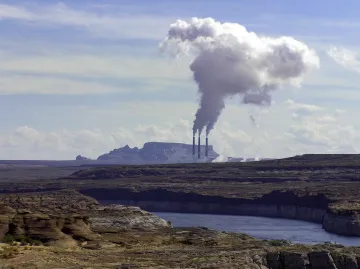Faculty Profile: Andrew Curley focuses on Indigenous and political geography

Andrew Curley. Photo by Leslie Epperson.
"My family is from Arizona. The Navajo Nation. I am pursuing an academic trajectory in Indigenous geography and political geography – what we call human geography." ~ Andrew Curley
Andrew Curley, an assistant professor in the School of Geography, Development & Environment at the University of Arizona, is Diné and a member of the Navajo Nation. He employs qualitative and quantitative research methods to understand relationships between development, culture, and economic inequality within Indigenous nations.

Navajo Generating Station
After finishing an undergraduate degree in sociology at Suffolk University, Curley worked for the Diné Policy Institute, researching social and political questions facing the Navajo Nation. At the time, Diné from various factions were hotly contesting the continued operation of the Navajo Generating Station, or NGS, the West's largest coal plant, near Page, Arizona.
Wanting to understand better what shaped the different perspectives of those for and against the coal plant, Curley enrolled at Cornell University, completing a Ph.D. in development sociology in 2016. He became an assistant geography professor at the University of North Carolina in 2018, before joining the University of Arizona in 2020.
"There is a mythology and narrative about Arizona that is understudied,” Curley said. “I wanted to come to this land-grant university to inquire about these histories."
Curley has been busy unraveling historical narratives that put Indigenous points of view at odds with what he calls "the settler's ontology,” ever since. “Non-Indigenous people have always approached the Southwest landscape with the idea of transforming it, often with risky calculations or short-sightedness, creating environmental crises over time," he said.
Due to the rising cost of operations and the advent of other energy sources, the NGS plant was shut down in 2019. Curley's years-long research and analysis about the coal plant will appear in his forthcoming book, Carbon Sovereignty: Coal, Development, and Energy Transition in the Navajo Nation, which will be published in April 2023 by University of Arizona Press. The book examines the personal consequences of the coal plant for the Diné and includes on-the-ground interviews with coal workers, environmental activists, and politicians.
While following the trail of coal extraction and the tangle of legal and political crosscurrents, Curley asked, "How did we get this coal industry in the first place?" The answer: The federal Bureau of Reclamation and power companies funded the coal plant to provide for the Central Arizona Project, or CAP, in 1968.
"CAP is still the largest energy consumer in Arizona," Curley says, explaining that since water naturally flows downhill, enormous amounts of power were required to pump trillions of gallons over mountains and across hundreds of miles to slake the thirsty states of Arizona, California, Colorado, Nevada, New Mexico, Utah, and Wyoming, as well as Mexico.
Currently, the Colorado River flow is waning, and states are scrambling to solve a problem often attributed to climate change. According to Curley, however, the large dams and other diversions on the Colorado River are structures of colonial intrusion as harmful as global warming, creating conditions for drought.
In addition to conducting research, Curley teaches his students how to use social scientific methods to shake out complex worldviews. He wants young scholars to understand that current government policy-making systems are not inevitable. They have been organized by people – for profit, for power over other cultures, or to wrestle natural systems into service.
"If you look at a map by the Department of the Interior in the 1960s, they represent rivers as if they are wholly intact things...but we miss their specificities, the niche ecologies where they exist in different kinds of environmental contexts,” Curley said. “The headwaters of the Colorado River are very different from the Delta. They have unique kinds of needs, even conservation needs."
Learn More about Andrew Curley’s Research
Curley's deep dive into the complex interactions between people and place has led to several recent podcasts, webinars, and articles, including:
“Understanding Water and Energy in the Navajo Nation, with Andrew Curley,” Resource Radio, 9/8/22
“The Central Arizona Project and the Taking of Diné (Navajo) Resources with Dr. Andrew Curley,” Crow Canyon Archaeological Center webinar, 5/26/22
“Indigenous Youth and Decolonial Futures: Energy and Environmentalism among the Diné in the Navajo Nation and the Lepchas of Sikkim, India,” (co-authored with Mabel Denzin Gergan) Antipode: A Radical Journal of Geography, 7/26/22
“Resources is Just Another Word for Colonialism,” The Routledge Handbook of Critical Resource Geography, 7/12/21

